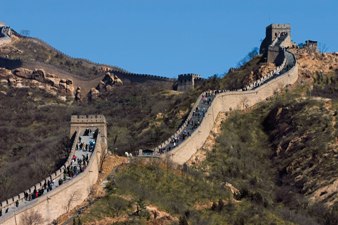The Great Wall
 Stretching from Shanhaiguan, by the Yellow Sea, to Jiayuguan Pass in the Gobi Desert, the Great Wall is an astonishing feat of engineering. The practice of building walls along China’s northern frontier began in the fifth century BC and continued until the sixteenth century. Over time, this discontinuous array of fortifications and ramparts came to be known as Wan Li Changcheng (literally, “Long Wall of Ten Thousand Li”, li being a Chinese measure of distance roughly equal to 500m), or “the Great Wall” to English-speakers. Even the most-visited section at Badaling, constantly overrun by Chinese and foreign tourists, is still easily one of China’s most spectacular sights. The section at Mutianyu is somewhat less crowded; distant Simatai and Jinshanling are much less so, and far more beautiful. To see the wall in all its crumbly glory, head out to Huanghua.
Stretching from Shanhaiguan, by the Yellow Sea, to Jiayuguan Pass in the Gobi Desert, the Great Wall is an astonishing feat of engineering. The practice of building walls along China’s northern frontier began in the fifth century BC and continued until the sixteenth century. Over time, this discontinuous array of fortifications and ramparts came to be known as Wan Li Changcheng (literally, “Long Wall of Ten Thousand Li”, li being a Chinese measure of distance roughly equal to 500m), or “the Great Wall” to English-speakers. Even the most-visited section at Badaling, constantly overrun by Chinese and foreign tourists, is still easily one of China’s most spectacular sights. The section at Mutianyu is somewhat less crowded; distant Simatai and Jinshanling are much less so, and far more beautiful. To see the wall in all its crumbly glory, head out to Huanghua.
Brief history
 The Chinese have walled their cities since earliest times and during the Warring States period (around the fifth century BC) simply extended the practice to separate rival territories. The Great Wall’s origins lie in these fractured lines of fortifications and in the vision of the first Emperor Qin Shi Huang who, having unified the empire in the third century BC, joined and extended the sections to form one continuous defence against barbarians.imgattraction/TheGreaWall1.jpg
The Chinese have walled their cities since earliest times and during the Warring States period (around the fifth century BC) simply extended the practice to separate rival territories. The Great Wall’s origins lie in these fractured lines of fortifications and in the vision of the first Emperor Qin Shi Huang who, having unified the empire in the third century BC, joined and extended the sections to form one continuous defence against barbarians.imgattraction/TheGreaWall1.jpg
Under subsequent dynasties, whenever insularity rather than engagement drove foreign policy, the wall continued to be maintained and, in response to shifting regional threats, grew and changed course. It lost importance under the Tang, when borders were extended north, well beyond it. The Tang was in any case an outward-looking dynasty that kept the barbarians in check far more cheaply by fostering trade and internal divisions. With the emergence of the insular Ming, however, the wall’s upkeep again became a priority, and from the fourteenth to the sixteenth century military, technicians worked on its reconstruction. The Ming wall is the one that you see today.
The 7m-high, 7m-thick wall, with its 25,000 battlements, served to bolster Ming sovereignty for a couple of centuries. It restricted the movement of the nomadic peoples of the distant, non-Han minority regions, preventing plundering raids. Signals made by gunpowder blasts, flags and smoke swiftly sent news of enemy movements to the capital. In the late sixteenth century, a couple of huge Mongol invasions were repelled, at Jinshanling and Badaling. But a wall is only as strong as its guards, and by the seventeenth century the Ming royal house was corrupt and its armies weak; the wall was little hindrance to the invading Manchus. After they had established their own dynasty, the Qing, they let the wall fall into disrepair. Slowly it crumbled away, useful only as a source of building material – demolitions of old hutongs in Beijing have turned up bricks from the wall, marked with the imperial seal.
Now this great monument to state paranoia is great business – the restored sections are besieged daily by rampaging hordes of tourists – and is touted by the government as a source of national pride. Its image adorns all manner of products, from wine to cigarettes, and is even used – surely rather inappropriately – on visa stickers.
The Great Wall China Beijing finder du i Beijing, og kan tilbyde dig en velbeliggende Bed and Breakfast B&B..
Hvis du vælger et ophold på The Great Wall China Beijing, eller bare en enkelt overnatning på The Great Wall China Beijing, kan du opleve følgende, blandt mange andre attraktioner i Beijing.
The Great Wall China, clik på The Great Wall China Beijing og reserver plads direkte på The Great Wall China hjemmeside. I kort afstand fra The Great Wall China i Beijing, kan du vælge en af de mange restauranter og spisesteder i Beijing
Telefon: The Great Wall China Homepage: The Great Wall China
Se bedømmelse  af The Great Wall China Beijing, Har du ris eller ros til denne Bed and Breakfast, Skriv din bedømmelse
af The Great Wall China Beijing, Har du ris eller ros til denne Bed and Breakfast, Skriv din bedømmelse